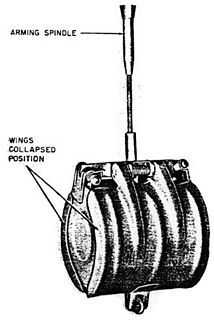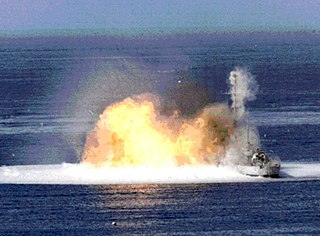 W
WAn anti-personnel weapon is a weapon primarily used to maim or kill infantry and other personnel not behind armor, as opposed to attacking structures or vehicles, or hunting game. The development of defensive fortification and combat vehicles gave rise to weapons designed specifically to attack them, and thus a need to distinguish between those systems and ones intended to attack people. For instance, an anti-personnel landmine will explode into small and sharp splinters that tear flesh but have little effect on metal surfaces, while anti-tank mines have considerably different design, using much more explosive power to effect damage to armored fighting vehicles, or use explosively formed penetrators to punch through armor plating. Note that while the stereotypical tank is effectively invulnerable to anti-personnel, a lightly armored vehicle will still take damage. Humvees, for example, have light armor and may still take severe damage from an anti-personnel weapon, such as a claymore. The issue has been patched by the add-on armor, but it can still be pierced by this type in some areas
 W
WA Butterfly Bomb was a German 2 kilogram anti-personnel submunition used by the Luftwaffe during the Second World War. It was so named because the thin cylindrical metal outer shell which hinged open when the bomblet deployed gave it the superficial appearance of a large butterfly. The design was very distinctive and easy to recognise. SD 2 bomblets were not dropped individually, but were packed into containers holding between 6 and 108 submunitions e.g. the AB 23 SD 2 and AB 250-3 submunition dispensers. The SD 2 submunitions were released after the container was released from the aircraft and had burst open. Because SD 2s were always dropped in groups the discovery of one unexploded SD 2 was a reliable indication that others had been dropped nearby. This bomb type was one of the first cluster bombs ever used in combat and it proved to be a highly effective weapon. The bomb containers that carried the SD 2 bomblets and released them in the air were nicknamed the "Devil's Eggs" by Luftwaffe air and ground crew.
 W
WEarly thermal weapons were used in warfare during the classical and medieval periods using heat or burning action to destroy or damage enemy personnel, fortifications or territories.
 W
WA Lazy Dog is a small, unguided kinetic projectile typically about 1.75 inches (44 mm) in length, 0.5 inches (13 mm) in diameter, and weighing about 0.7 ounces (20 g).
 W
WThe Minenabwurfvorrichtung was an anti-personnel mine launcher used to disperse S-Mines. It was typically found on German tanks such as the Panzer III and Tiger I from 1942 through 1943. The Minenabwurfvorrichtung was a simple device consisting of a small steel tube oriented at a 50° angle mounted to the hull roof or track guards of the tank. The tube contained a modified version of the infantry S-Mine equipped with the Glühzünder 28 fuze which allowed it to be electrically fired from the inside of the vehicle using a small control panel labeled Minenabwurfschalter that was mounted on the engine firewall. The mine itself consisted of a round projectile about 12.7 centimetres (5 in) deep by 10 centimetres (4 in) wide and contained about 360 steel balls. The projectile was fired about 0.9 to 1.5 meters into the air, where it would explode, scattering the steel balls in all directions. Starting in June 1942, up to six launchers were mounted on the track guards of an unknown number of Panzerkampfwagen III Ausführung L tanks and were issued for troop testing to the 13th Panzer Division. The device was subsequently adopted as standard equipment on new production Tiger I tanks during January through October 1943. On the standard Tiger I, five launchers were mounted around the periphery of the hull roof, one at each corner and one halfway along the left hull side. As future plans were being made to install the 360° traversable Nahverteidigungswaffe, fired from the interior of the turret, the Minenabwurfvorrichtung was discontinued in early October 1943 after only a few hundred Tiger Is had been equipped with them.
 W
WThe Nahverteidigungswaffe was a roof mounted, breech-loaded, single shot, multi-purpose, 360° rotating grenade launcher that could fire a variety of ammunition. It was typically found on German tanks such as the Panzer IV, Panther I, Tiger I, and Tiger II from 1944 until the end of the war and was intended to replace three previous devices: the Nebelwurfgerät, the Minenabwurfvorrichtung, and pistol ports. The Nahverteidigungswaffe was a simple breech-loaded launcher tube oriented at a 50° angle and fitted in a traversable mounting on the turret roof. Unlike the previous externally mounted launchers, it was not exposed to enemy fire, being reloaded from within the vehicle through a hinged breech. The Nahverteidigungswaffe was designed to mate with the standard 26 millimetres (1 in) Kampfpistole and could be sealed by an armored plug when not in use. Aiming was by periscopes located on the turret and cupola. The device could fire the Schnellnebelkerze 39 smoke grenade for the purpose of concealment, the Rauchsichtzeichen Orange 350 smoke signal for identification to friendly aircraft, the Leuchtgeschoss R flare and the Sprenggranatpatrone 326 Lp anti-personnel explosive to defend the vehicle against infantry attack. The Sprenggranatpatrone 326 Lp had a range of 7 to 10 meters with a blast point of 0.5 to 2 meters above the ground. It splintered to a circumferential distance of 100 meters (328 ft) after an initial delay time of one second. All turret hatches and openings were to be closed when this round was fired. The Nahverteidigungswaffe was first mounted in March 1944 on the Panther tank and equipped a variety of late-war vehicles, including the Sturmtiger and the Maus tank.
 W
WNon-lethal weapons, also called less-lethal weapons, less-than-lethal weapons, non-deadly weapons, compliance weapons, or pain-inducing weapons are weapons intended to be less likely to kill a living target than conventional weapons such as knives and firearms. It is often understood that unintended or incidental casualties are risked wherever force is applied, but non-lethal weapons try to minimise the risk of casualties as much as possible. Non-lethal weapons are used in policing and combat situations to limit the escalation of conflict where employment of lethal force is prohibited or undesirable, where rules of engagement require minimum casualties, or where policy restricts the use of conventional force. These weapons occasionally cause serious injuries or death; the term "less-lethal" has been preferred by some organizations as it describes the risks of death more accurately than the term "non-lethal", which some have argued is a misnomer.
 W
WA thermobaric weapon, aerosol bomb, or vacuum bomb is a type of explosive that uses oxygen from the surrounding air to generate a high-temperature explosion. In practice, the blast wave typically produced by such a weapon is of a significantly longer duration than that produced by a conventional condensed explosive. The fuel–air explosive (FAE) is one of the best-known types of thermobaric weapon.
 W
WA tripwire is a passive triggering mechanism. Typically, a wire or cord is attached to some device for detecting or reacting to physical movement.